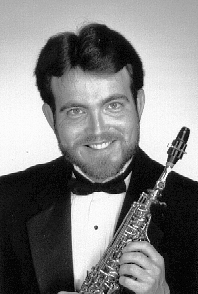|
(U.S.A.)
|
 |
||||||
Sonata (1995) avec la participation de: with the participation of: Dr. Kathryn Fouse, piano |
|||||||
| Eric M. Nestler has been on the faculty of the University of North Texas since 1992 and is currently an Associate Professor of Music. Prior to his appoinment at UNT, Mr. Nestler taught both Woodwind Techniques and the Sophomore Honors Section Form and Analysis Class at the Indiana University School of Music. Additionally, he has taught studio woodwinds and coached chamber ensembles at Vincennes University, IN. Nestler is presently a member of the summer music faculty of the University of New Brunswick in Fredericton, New Brunswick, Canada.
Mr. Nestler earned a Bachelor of Music degree in Music Education, Summa Cum Laude, from Susquehanna University (Selinsgrove, PA) where he was a student of Donald Beckie. Mr. Nestler has since received both the Master of Music degree in Woodwind Instruments, with High Distinction, and the Doctor of Music Literature and Performance degree in Saxophone, Clarinet, and Bassoon, with High Distinction, from the Indiana University School of Music (Bloomington, IN). He studied with Eugene Rousseau (saxophone), James Campbell (clarinet), and Sidney Rosenberg (bassoon). |
|||||||
| Sonata for Alto Saxophone and Piano was commissioned by Eric Nestler with the support of the University of North Texas. The premiere was given by Eric Nestler and Kathryn Fouse on December 3, 1995, at the University of North Texas, Denton, TX.
"The subtitle of the first movement of my Sonata for Alto Saxophone and Piano, Arabesque, came about because the music I was imagining features highly ornamented, intricately swirled melodic lines, which are often presented in canonic textures. The form of this movement also reflects the symmetry of an arabesque, the eleven sections of the movement falling into a palindrome, which has it's axis in the central 3/8 section. "Reflections, the second movement, is through composed, and except for a couple brief outbursts, has the dream-like quality of a nocturne. Most of the material here comes from the first movement, though it is transformed, as if reflected on a body of water by moonlight. "Reverberations makes use of another symmetrical form, though not as straight forward as a palindrome. If one were to toss two rondos into a blender, this form might be the result. This fast movement begins with alternations of three ideas (a, b, c), each of which are given four presentations which decrease in duration. One third of the way into the movement, this music is elided with three other ideas (x, y, z), also given four presentations each, this time increasing in duration. The result is the following form: abacbaxcbayxcbzyxczyxzyz. Whatever. Hopefully, because of the differences in (a,b,c) and (x,y,z), what comes across is a movement which begins with fairly static music with a lot of repetition, has a central, quasi-development section which is unstable in its rapid alternations, and works towards longer, goal oriented, less repetitive music in the last third. In addition to actual reverberations or echos in the music, this movement also reverberates material from the earlier movements." –David Dzubay |
|||||||
|